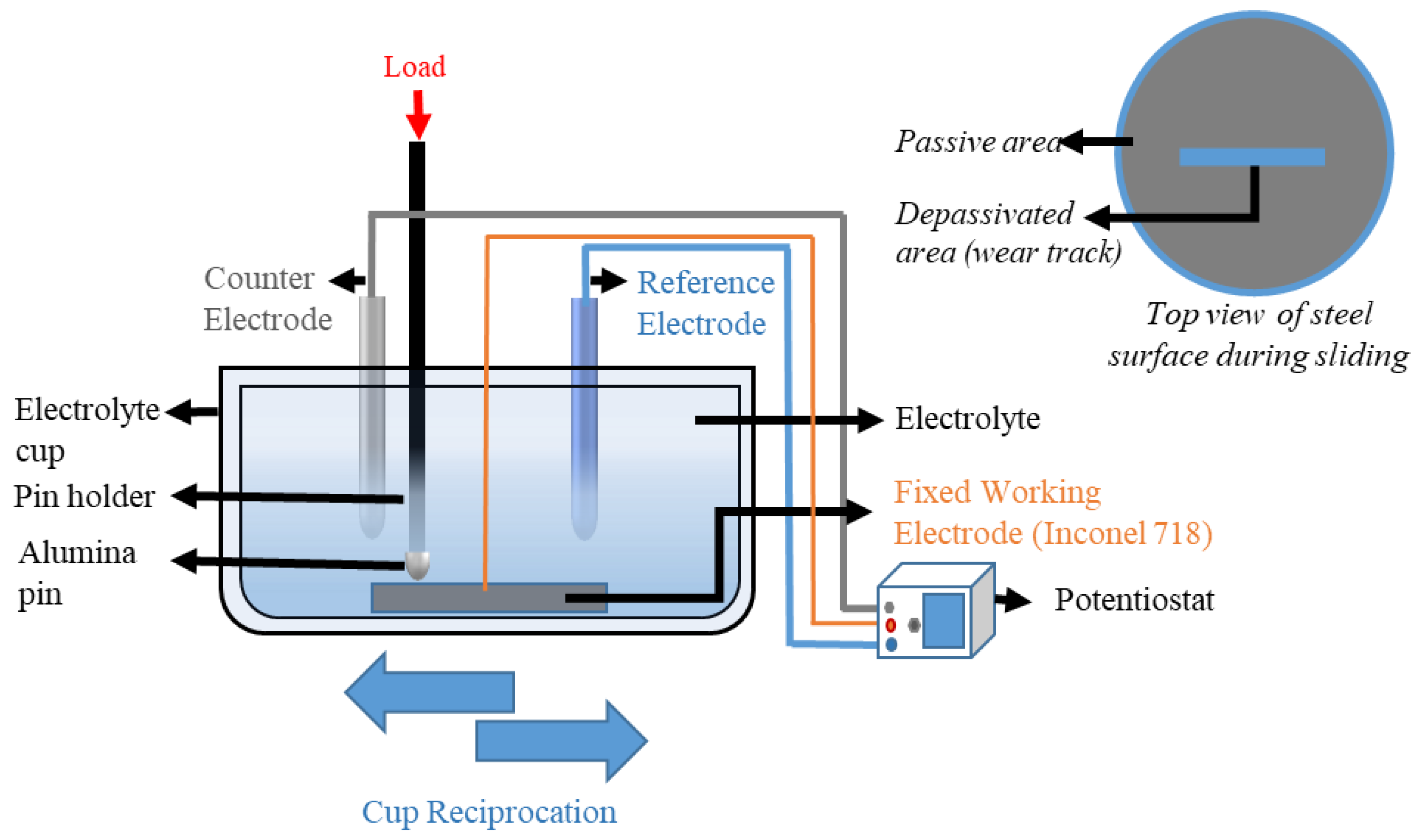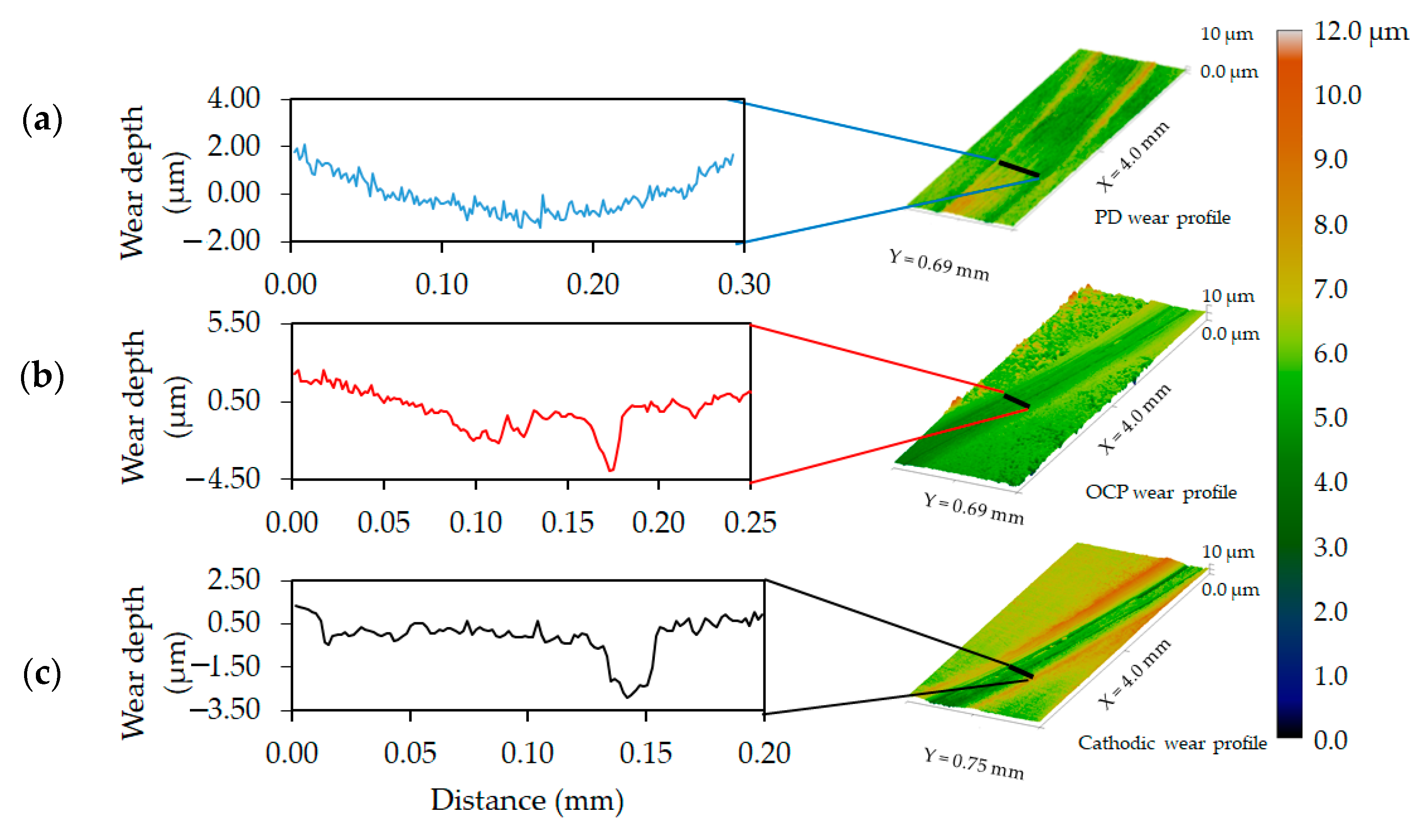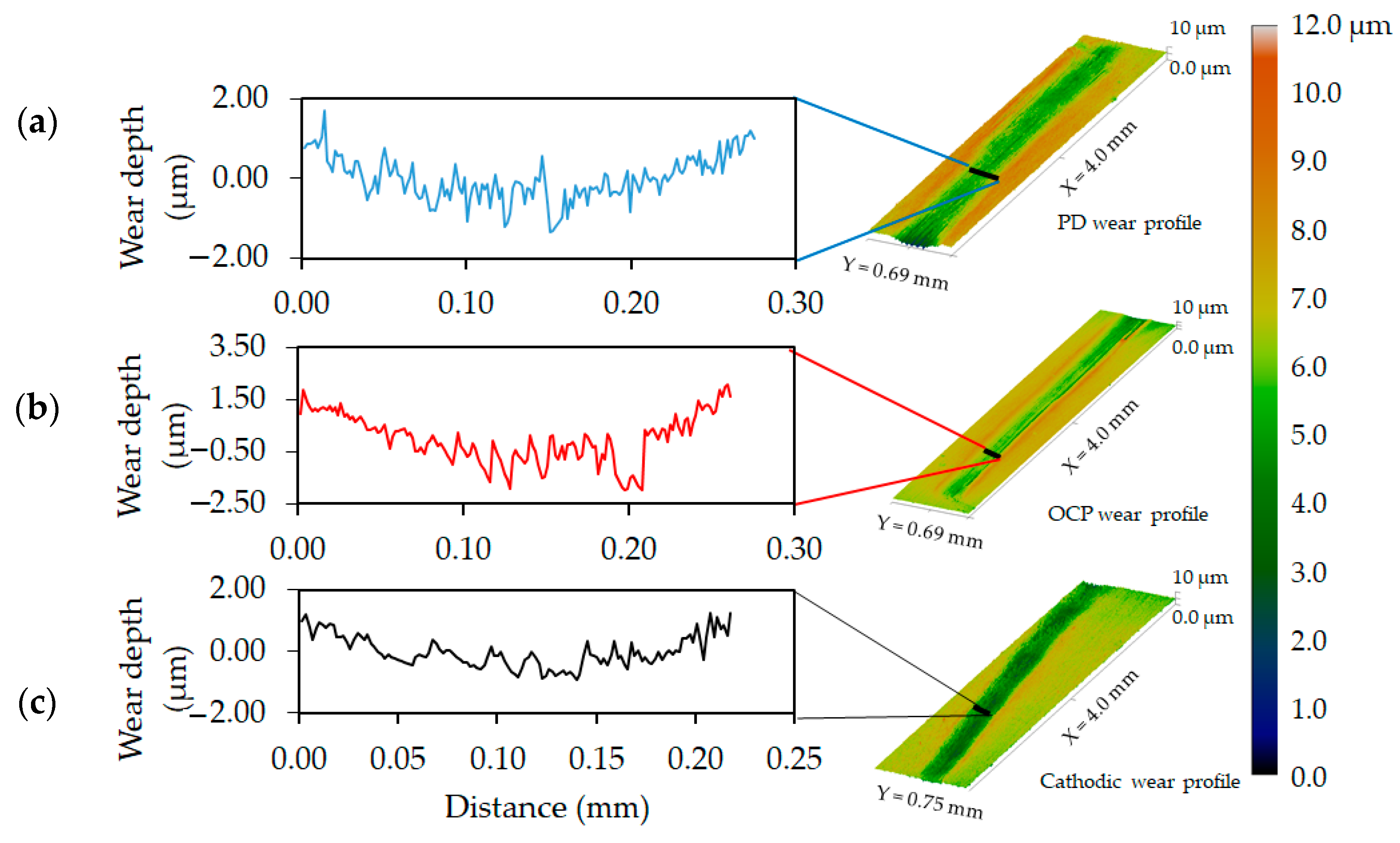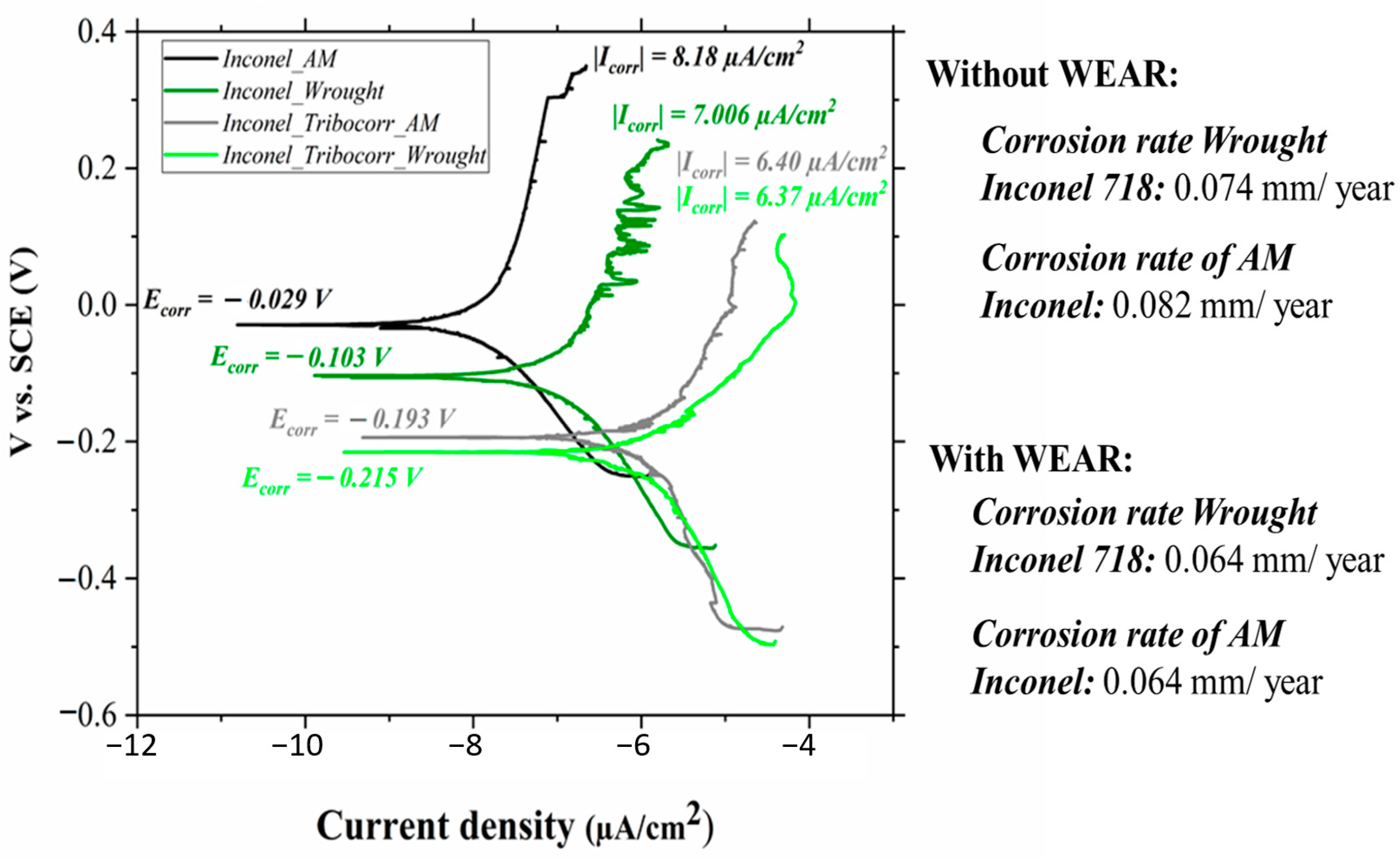Tribocorrosion Behavior of Inconel 718 Fabricated by Laser Powder Bed Fusion-Based Additive Manufacturing
Abstract
1. Introduction
2. Materials and Methods
2.1. Materials and Electrolyte
2.2. Open Circuit Potential (OCP) Measurements
2.3. Tribocorrosion Tests
- (1)
- First, the experiment will be performed using the tribocorrosion monitoring test setup (Figure 1) developed in-house [21]. The setup consists of a pin-on-disk setup, and an electrochemical cell with three-electrode configuration. The total material wear rate (T) of the disk was be measured while monitoring the equilibrium potential during sliding against alumina ball.
- (2)
- Second, the rate of degradation of the disk was determined by measuring corrosion rate in the absence of wear (Co). The same setup (Figure 1) was used without sliding to measure the corrosion rate without wear. The corrosion rate was calculated by a series of electrochemical measurements involving, (i) measuring the equilibrium potential of the disk material, (ii) polarization resistance measurements, (iii) measuring the equilibrium potential of the disk material, and (iv) potentiodynamic polarization tests. The electrochemical corrosion current density was calculated using the results from these tests, and the Co will be obtained by applying Faraday’s law (Equation (3)).
- (3)
- Third, the rate of disk degradation in the absence of corrosion (Wo) was determined. The working electrode on the test setup was polarized cathodic with respect to corrosion potential (Ecorr) to suppress corrosion, and the wear data was collected. The rate of material loss on the disk at the end of the experiment was calculated in Equation (4). This rate of material loss will provide the Wo.
- (4)
- Fourth, the total corrosion component (Cw) was estimated. Experiments were performed using the test set-up (Figure 1). This stage involved a wear test in addition to the electrochemical experiments from the second stage. The electrochemical corrosion current density as influenced by the wear was calculated using the results from these tests. The Cw was then obtained by applying Faraday’s law (Equation (3)).
3. Results and Discussion
3.1. Wear Volume during Tribocorrosion
3.2. Corrosion Rate during Tribocorrosion
4. Conclusions
- (a)
- The corrosive environment increases the wear by 29.24% and 49.5% without the initiation of corrosion in the case of AM and wrought Inconel 718, respectively.
- (b)
- The onset of corrosion in case of AM Inconel 718 is delayed by 71.8% as compared to the wrought counterpart.
- (c)
- The late onset of corrosion degradation (high corrosion resistance potential) provides better tribocorrosion resistance in the case of AM Inconel 718.
- (d)
- Both AM and wrought Inconel 718 have similar corrosion rates during tribocorrosion, but the wear volume in case of AM is much lower (1.22 mm3) as compared to wrought (2.57 mm3)
- (e)
- A corrosion-accelerated wear form of tribocorrosion is observed for Inconel 718.
- (f)
- The corrosive environment has a significant effect on wear even when the Inconel 718 surface is in equilibrium potential with the corrosive environment, and no corrosion potential scan is applied.
Author Contributions
Funding
Institutional Review Board Statement
Informed Consent Statement
Data Availability Statement
Acknowledgments
Conflicts of Interest
References
- Rahman, M.; Seah, W.K.H.; Teo, T.T. The machinability of inconel 718. J. Mater. Process. Technol. 1997, 63, 199–204. [Google Scholar] [CrossRef]
- Xavior, M.A.; Patil, M.; Maiti, A.; Raj, M.; Lohia, N. Machinability studies on INCONEL 718. IOP Conference Series: Materials Science and Engineering. In Proceedings of the International Conference on Advances in Materials and Manufacturing Applications (IConAMMA-2016), Bangalore, India, 14–16 July 2016. [Google Scholar]
- Iturbe, A.; Giraud, E.; Hormaetxe, E.; Garay, A.; Germain, G.; Ostolaza, K.; Arrazola, P.J. Mechanical characterization and modelling of Inconel 718 material behavior for machining process assessment. Mater. Sci. Eng. A 2017, 682, 441–453. [Google Scholar] [CrossRef]
- Wang, X.; Gong, X.; Chou, K. Review on powder-bed laser additive manufacturing of Inconel 718 parts. Proc. Inst. Mech. Eng. Part B J. Eng. Manuf. 2016, 231, 1890–1903. [Google Scholar] [CrossRef]
- Jia, Q.; Gu, D. Selective laser melting additive manufacturing of Inconel 718 superalloy parts: Densification, microstructure and properties. J. Alloys Compd. 2014, 585, 713–721. [Google Scholar] [CrossRef]
- Zhang, B.; Liao, H.; Coddet, C. Selective laser melting commercially pure Ti under vacuum. Vacuum 2013, 95, 25–29. [Google Scholar] [CrossRef]
- Kumar, P.; Farah, J.; Akram, J.; Teng, C.; Ginn, J.; Misra, M. Influence of laser processing parameters on porosity in Inconel 718 during additive manufacturing. Int. J. Adv. Manuf. Technol. 2019, 103, 1497–1507. [Google Scholar] [CrossRef]
- Morton, P.A.; Taylor, H.C.; Murr, L.E.; Delgado, O.G.; Terrazas, C.A.; Wicker, R.B. In situ selective laser gas nitriding for composite TiN/Ti-6Al-4V fabrication via laser powder bed fusion. J. Mater. Sci. Technol. 2020, 45, 98–107. [Google Scholar] [CrossRef]
- Fox, P.; Pogson, S.; Sutcliffe, C.J.; Jones, E. Interface interactions between porous titanium/tantalum coatings, produced by Selective Laser Melting (SLM), on a cobalt–chromium alloy. Surf. Coat. Technol. 2008, 202, 5001–5007. [Google Scholar] [CrossRef]
- Krakhmalev, P.; Yadroitsev, I. Microstructure and properties of intermetallic composite coatings fabricated by selective laser melting of Ti–SiC powder mixtures. Intermetallics 2014, 46, 147–155. [Google Scholar] [CrossRef]
- Heiden, M.J.; Deibler, L.A.; Rodelas, J.M.; Koepke, J.R.; Tung, D.J.; Saiz, D.J.; Jared, B.H. Evolution of 316L stainless steel feedstock due to laser powder bed fusion process. Addit. Manuf. 2019, 25, 84–103. [Google Scholar] [CrossRef]
- Barros, R.; Silva, F.J.G.; Gouveia, R.M.; Saboori, A.; Marchese, G.; Biamino, S.; Salmi, A.; Atzeni, E. Laser powder bed fusion of Inconel 718: Residual stress analysis before and after heat treatment. Metals 2019, 9, 1290. [Google Scholar] [CrossRef]
- Luo, S.; Huang, W.; Yang, H.; Yang, J.; Wang, Z.; Zeng, X. Microstructural evolution and corrosion behaviors of Inconel 718 alloy produced by selective laser melting following different heat treatments. Addit. Manuf. 2019, 30, 100875. [Google Scholar] [CrossRef]
- Zhang, B.; Xiu, M.; Tan, Y.T.; Wei, J.; Wang, P. Pitting corrosion of SLM Inconel 718 sample under surface and heat treatments. Appl. Surf. Sci. 2019, 490, 556–567. [Google Scholar] [CrossRef]
- Zhang, L.N.; Ojo, O.A. Corrosion behavior of wire arc additive manufactured Inconel 718 superalloy. J. Alloys Compd. 2020, 829, 154455. [Google Scholar] [CrossRef]
- Du, D.; Dong, A.; Shu, D.; Zhu, G.; Sun, B.; Li, X.; Lavernia, E. Influence of build orientation on microstructure, mechanical and corrosion behavior of Inconel 718 processed by selective laser melting. Mater. Sci. Eng. A 2019, 760, 469–480. [Google Scholar] [CrossRef]
- ASTM B637-18. Standard Specification for Precipitation-Hardening and Cold Worked Nickel Alloy Bars, Forgings, and Forging Stock for Moderate or High Temperature Service; ASTM International: West Conshohocken, PA, USA, 2018. [Google Scholar]
- ASTM B895-16(2020)e1. Standard Test Methods for Evaluating the Corrosion Resistance of Stainless Steel Powder Metallurgy (PM) Parts/Specimens by Immersion in a Sodium Chloride Solution; ASTM International: West Conshohocken, PA, USA, 2020. [Google Scholar]
- Archard, J.F. Contact and Rubbing of Flat Surfaces. J. Appl. Phys. 1953, 24, 981–988. [Google Scholar] [CrossRef]
- ASTM G119-09(2016). Standard Guide for Determining Synergism Between Wear and Corrosion; ASTM International: West Conshohocken, PA, USA, 2016. [Google Scholar]
- Siddaiah, A.; Khan, A.Z.; Ramachandran, R.; Menezes, L.P. Performance Analysis of Retrofitted Tribo-Corrosion Test Rig for Monitoring In Situ Oil Conditions. Materials 2017, 10, 1145. [Google Scholar] [CrossRef] [PubMed]
- Wang, J.; Xu, J.; Zhang, X.; Ren, X.; Song, X.; Chen, X. An investigation of surface corrosion behavior of Inconel 718 after robotic belt grinding. Materials 2018, 11, 2440. [Google Scholar] [CrossRef] [PubMed]
- Guo, P.; Lin, X.; Li, J.; Zhang, Y.; Song, M.; Huang, W. Electrochemical behavior of Inconel 718 fabricated by laser solid forming on different sections. Corros. Sci. 2018, 132, 79–89. [Google Scholar] [CrossRef]
- Silverman, D.C. Tutorial on Cyclic Potentiodynamic Polarization Technique. In Proceedings of the CORROSION/98 Research Topical Symposium; NACE: San Diego, CA, USA, 1998; p. 21. [Google Scholar]
- Davydov, A.D.; Shaldaeva, V.S.; Malofeevaa, A.N.; Chernyshovab, O.V.; Volgina, V.M. Determination of corrosion rate of rhenium and its alloys. Chem. Eng. 2014, 41, 289–294. [Google Scholar]




| Sample | Material Loss Rate, (mm3/mm2·year) | ||||||
|---|---|---|---|---|---|---|---|
| T | Wo | Co | Cw | S | ΔCw | ΔWc | |
| Inconel AM | 107.05 | 106.26 | 0.08 | 0.06 | 0.07 | −0.02 | 0.72 |
| Inconel Wrought | 225.40 | 100.40 | 0.07 | 0.06 | 124.93 | −0.01 | 124.94 |
Publisher’s Note: MDPI stays neutral with regard to jurisdictional claims in published maps and institutional affiliations. |
© 2021 by the authors. Licensee MDPI, Basel, Switzerland. This article is an open access article distributed under the terms and conditions of the Creative Commons Attribution (CC BY) license (http://creativecommons.org/licenses/by/4.0/).
Share and Cite
Siddaiah, A.; Kasar, A.; Kumar, P.; Akram, J.; Misra, M.; Menezes, P.L. Tribocorrosion Behavior of Inconel 718 Fabricated by Laser Powder Bed Fusion-Based Additive Manufacturing. Coatings 2021, 11, 195. https://doi.org/10.3390/coatings11020195
Siddaiah A, Kasar A, Kumar P, Akram J, Misra M, Menezes PL. Tribocorrosion Behavior of Inconel 718 Fabricated by Laser Powder Bed Fusion-Based Additive Manufacturing. Coatings. 2021; 11(2):195. https://doi.org/10.3390/coatings11020195
Chicago/Turabian StyleSiddaiah, Arpith, Ashish Kasar, Pankaj Kumar, Javed Akram, Manoranjan Misra, and Pradeep L. Menezes. 2021. "Tribocorrosion Behavior of Inconel 718 Fabricated by Laser Powder Bed Fusion-Based Additive Manufacturing" Coatings 11, no. 2: 195. https://doi.org/10.3390/coatings11020195
APA StyleSiddaiah, A., Kasar, A., Kumar, P., Akram, J., Misra, M., & Menezes, P. L. (2021). Tribocorrosion Behavior of Inconel 718 Fabricated by Laser Powder Bed Fusion-Based Additive Manufacturing. Coatings, 11(2), 195. https://doi.org/10.3390/coatings11020195








